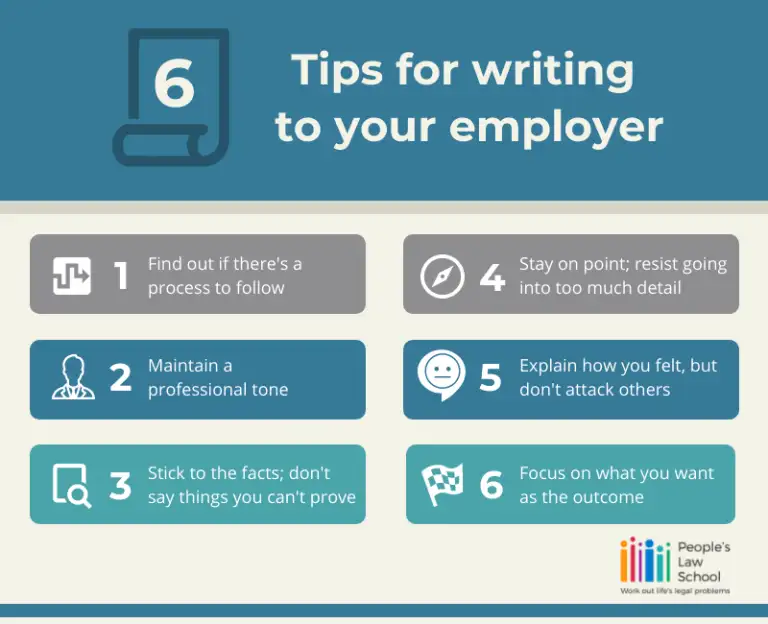
Often, issues at work can be sorted out through having an honest, respectful conversation. But sometimes more formal action is needed. Whether it’s bringing forward a concern or making a request (for example, asking for a raise or more flexible work arrangements), writing a clear and respectful letter can be an effective way to express yourself. We offer tips to help you write a letter to your employer.
What you should know
If you have an issue at work, you have options as to how to bring it forward. In addition to writing a letter, these include having a conversation, making a formal complaint, or bringing legal action. The option you choose will depend on the nature of the issue, the kind of job you have, and how successful you think a particular step might be. You don’t have to go through these options in any particular order. You can start with whatever step best fits your situation.
Before you write a letter, take steps to find out what legal rights you have and what you can reasonably expect your employer to agree to. See our guidance on your rights at work, getting paid, time off work, and getting fired or leaving a job.
Be sure to check what you’ll need to do. For example, if you want to request a parental leave, you need to make the request in writing at least four weeks before you expect to go on leave.
If you have a policy at work that sets out a process to follow to deal with a certain issue, you should follow that process.
An employer can’t fire you for just cause for raising a workplace issue, making a request, or bringing a complaint. But unfortunately, some bosses are short-tempered and don’t react well to being confronted.
This doesn’t mean you shouldn’t ask for that raise or address a simmering concern. But it does mean you should be strategic and respectful about how you ask, and when.
There are several laws that protect you if your employer fires you for raising a complaint. If you get fired for bringing a discrimination complaint, you may have grounds to make a human rights claim. If you get fired for a workplace safety or harassment complaint, you can make a “prohibited action complaint” to WorkSafeBC. Being fired for bringing a complaint might also justify extra damages if you sue in court.
However, be aware that unless there are certain factors in play (human rights issues, for example), your employer can fire you at any time as long as they give you enough advance notice or severance pay. (The amount of notice or severance depends on what’s written in your employment contract — or the minimum you’re entitled to by law.)
Steps to write the letter
Whether you’re raising concerns about a problem at work or making a request of your employer, find out if your workplace has a process to follow. Some workplaces, particularly larger ones, have a form you’re asked to complete or a specific person or department to contact. It’s best to use the official form if one exists. Otherwise, you can write a letter or an email.
Before you write your letter, pull your thoughts together, as well as any paperwork supporting your position.
Make notes of your concerns and what you want to achieve. If there was a specific incident, write down the date and place it happened, how it made you feel, and who witnessed it. Describe any conversations you’ve had about it with anyone since then (don’t mention conversations with your lawyer or doctor).
Think hard about the outcome you want. How do you hope your employer responds? One way to think about this is to put yourself in their shoes. Ask yourself: What would I do if I were them? If you want your employer to formally investigate your complaint, either following a process set out in a policy manual or otherwise, make this clear to them. If you can make concrete and reasonable suggestions, you’ll give your employer something to work with. You’re more likely to get at least part of the solution you’re after.
Gather together anything that supports your position — any emails or letters that relate to the issue, your paystubs (if part of your pay was missing, for example), your written employment contract (if you have one). If there are any specific laws that apply to your situation, make sure you understand them and consider if you want to raise them in writing with your employer. The Employment Standards Branch and WorkSafeBC have legal information sheets for employers, which you could consider attaching to a letter in appropriate circumstances.
We offer a template letter to deal with a problem at work. Here’s a walkthrough of what you might put in your letter:
Calmly and respectfully explain what the issue is. Include as much relevant detail as you can think of, including the dates of any incidents and who was involved. If your complaint is that you haven’t been paid, or paid enough, say how much you think your employer owes you.
Explain briefly the impact on you. Describe how the issue has made you feel. Avoid attacking your employer or other staff.
Describe the steps you’ve taken so far. If you tried to resolve the situation informally first, mention that and say what the outcome was.
Suggest a solution. Say as clearly as you can what steps you would like your employer to take to make things work for you. You may not get everything you want, and with that in mind you might suggest an alternative solution you could live with if your preferred solution isn’t accepted.
Ask for a response by a certain date. For example, “Can you please let me know how you will be addressing this issue by [date]”. Generally, one week is a reasonable timeline.
Make sure your letter is dated and signed. Include copies of any supporting evidence with your letter. Keep a copy for yourself.
Who can help

Employment Standards Branch
The BC government office that deals with complaints against employers.

Employment and Social Development Canada
Deals with complaints against employers in federally-regulated industries.

WorkSafeBC
Deals with complaints about unsafe working conditions and injuries on the job.

BC Human Rights Tribunal
Deals with discrimination complaints under BC law.



